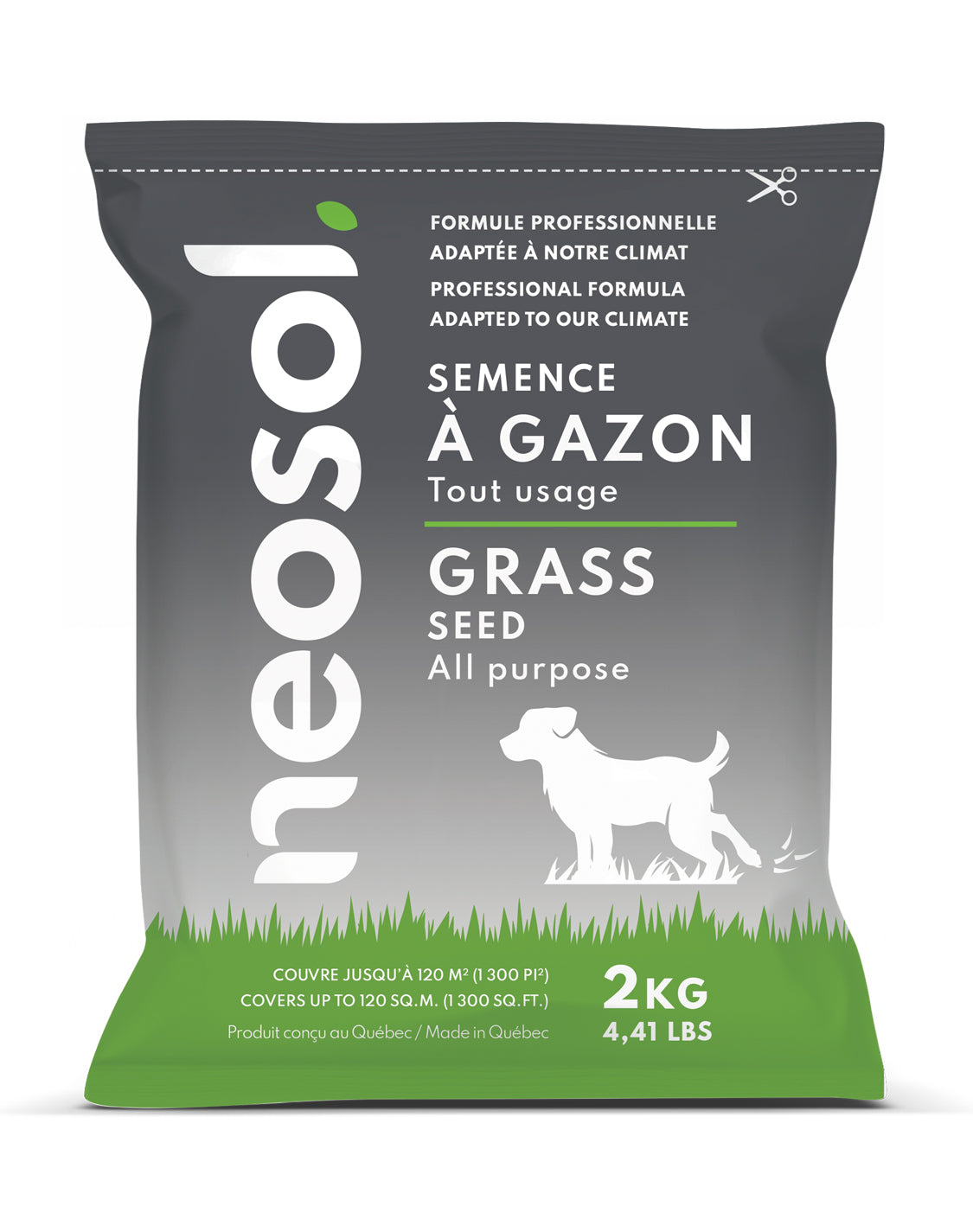Neosol Lawncare
All Purpose Grass Seed - 2kg
All Purpose Grass Seed - 2kg
Couldn't load pickup availability
 Visible result in less than 7 days
Visible result in less than 7 days
 Designed for harsh climates
Designed for harsh climates
 Canada No. 1 Lawn Mix
Canada No. 1 Lawn Mix
- Perfect for lawns exposed to the sun, but also in the shade .
-
Perfect for surfaces subject to heavy foot traffic .
Description
Neosol All Purpose Seed allows you to have new grass very quickly. Density improves in less than 7 days, the lawn becomes more resistant to trampling and drought and having a dense lawn allows you to have a lawn with fewer weeds. This mixture is very popular among the population due to its excellent quality- price ratio.
Blanket
New seed coverage: 2 kg covers 75 m2 / 810 ft2
Reseeding coverage: 2 kg covers 120 m2 / 1300 ft2
Mélange
Mélange
40% Creeping Red Fescue
20% Kentucky Bluegrass
40% Perennial ryegrass
Utilisation
Utilisation
Repairing dead grass patches / Repairing dead grass patches
- Mow the lawn very short, about 2 in.
- Rake yellowed or damaged lawn
- Pull out as many weeds as possible
- Spread a 1/2-inch thick layer of seed compost over the entire desired surface.
- Spread the seeds evenly.
- Add a layer of potting soil about 1/4 inch over the entire surface.
- Keep the soil moist until the lawn is established (without waterlogging), for about 20 days. The spray should be gentle so as not to wash away the seeds.
- Mow the lawn when it is about 4 inches tall.
Re-seed and overseed
Reseeding helps increase the density of your lawn and reduce weed growth.
- Aerate the soil (ideally)
- Mow the lawn very short, about 5 cm (2 in)
- Pull out as many weeds as possible.
- Spread the seeds evenly, making sure they come into contact with the soil.
- Keep the soil moist until the lawn is established (without saturating it with water), for about 20 days.
Seeding a new lawn
- Clear the surface of any debris.
- Spread a 4 to 6 inch layer of potting soil over the entire surface
-Spread the seeds evenly.
-Add a layer of potting soil about 1/4 inch over the entire surface.
-Keep the soil moist until the lawn is established (without it being saturated with water), for about 20 days. The jet must be weak so as not to carry away the seeds.
-Mow the lawn when it has reached a height of approximately 4 inches.
Livraison
Livraison
Gratuite avec tout achat de 125$ et plus.
Partager


FAQ
What makes all-purpose seed different from other seeds?
1. Creeping red fescue (40%):
Shade Tolerance: Good ability to grow in partially shaded areas, increasing the versatility of the mix.
Drought Resistance: Excellent drought tolerance, allowing for a green lawn even in arid conditions.
Propagation by rhizomes: Spreads via rhizomes, which provides a dense, even coverage, ideal for repairing damaged areas.
2. Kentucky bluegrass (20%):
Durability: Forms a dense, durable turf, perfect for general purpose lawns.
Stress Resistance: Excellent resistance to heat and drought, contributing to the overall robustness of the lawn.
Fast recovery: Good regenerative capacity after periods of stress or damage.
3. Perennial ryegrass (40%):
Rapid germination: The first shoots appear in 5 to 10 days, allowing rapid soil coverage.
Trampling Resistance: Tolerates moderate trampling well, making it ideal for residential lawns and play areas.
Adaptability: Adapts well to different soil and climate conditions, adding to the versatility of the mix.
Distinctive features:
Versatility: The mix is suitable for a wide variety of conditions including sunny, partially shaded, dry or moist areas.
Speed of establishment: Thanks to the significant presence of perennial ryegrass, the lawn establishes quickly, providing rapid initial coverage.
Resilience and durability: The combination of these grasses ensures a durable lawn, capable of withstanding trampling and varied climatic conditions.
Weed Reduction: Dense coverage reduces the opportunity for weed growth, ensuring a healthier, more aesthetically pleasing lawn.
When to sow?
Spring :
When?: From mid-April to mid-June.
Advantages: The soil warms up, and temperatures are moderate, which promotes rapid germination and good growth of young plants. In addition, spring rains help keep the soil moist.
Disadvantages: Competition with weeds may be more intense, and regular watering may be necessary if the spring is dry.
Late summer to early fall:
When?: From mid-August to the end of September.
Pros: Temperatures are still warm, but nights are getting cooler, creating ideal conditions for grass germination and establishment. There is generally less competition from weeds, and the soil stays moist thanks to fall rainfall.
Disadvantages: Time for establishment before winter sets in is limited, so it is crucial to sow early enough to allow young plants to root.
By seeding in spring or late summer, you give your lawn the best chance to establish and thrive.
How to sow a new lawn?
- Clear the surface of any debris.
- Spread a 4 to 6 inch layer of potting soil over the entire surface
-Spread the seeds evenly.
-Add a layer of potting soil about 1/4 inch over the entire surface.
-Keep the soil moist until the lawn is established (without it being saturated with water), for about 20 days. The jet must be weak so as not to carry away the seeds.
-Mow the lawn when it has reached a height of approximately 4 inches.
How to seed a new lawn or overseed?
- Aerate the soil (ideally)
- Mow the lawn very short, about 5 cm (2 in)
- Pull out as many weeds as possible.
- Spread the seeds evenly, making sure they come into contact with the soil.
- Keep the soil moist until the lawn is established (without saturating it with water), for about 20 days.
How to repair dead grass patches / repair dead grass patches?
- Mow the lawn very short, about 2 in.
- Rake yellowed or damaged lawn
- Pull out as many weeds as possible
- Spread a 1/2-inch thick layer of seed compost over the entire desired surface.
- Spread the seeds evenly.
- Add a layer of potting soil about 1/4 inch over the entire surface.
- Keep the soil moist until the lawn is established (without it being saturated with water), for about 20 days. The jet must be weak so as not to carry away the seeds.
- Mow the lawn when it has reached a height of approximately 4 inches.
How to use grass seed with other products?
Seed should be applied 5 to 7 days after using a herbicide. Herbicide should not be applied to new seedlings until four weeks after seeding. Fertilizer can be applied before, during, or after seeding. Insecticide can be applied before, during, or after seeding.
How long does it take before you see some grass?
With the composition of the seed mix, germination times may vary depending on the grass species included. Here is an overview of typical germination times for each type of seed in this mix:
Creeping red fescue (40%): 10 to 14 days
Kentucky Bluegrass (20%): 14 to 21 days
Perennial ryegrass (40%): 5 to 10 days
Estimated first shoots:
Since perennial ryegrass is one of the dominant species and has the shortest germination time, you can expect to see the first perennial ryegrass shoots appear in about 5 to 10 days after sowing. The other species will follow:
Perennial ryegrass: 5 to 10 days
Creeping red fescue: 10 to 14 days
Kentucky Bluegrass: 14 to 21 days
Conclusion :
You should start seeing the first shoots of your lawn in about 5 to 10 days, mainly due to the rapid germination of perennial ryegrass. Creeping red fescues will follow shortly after, in 10 to 14 days, while Kentucky bluegrass will take the longest, with visible shoots in 14 to 21 days.






